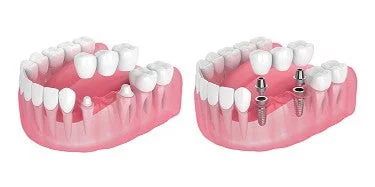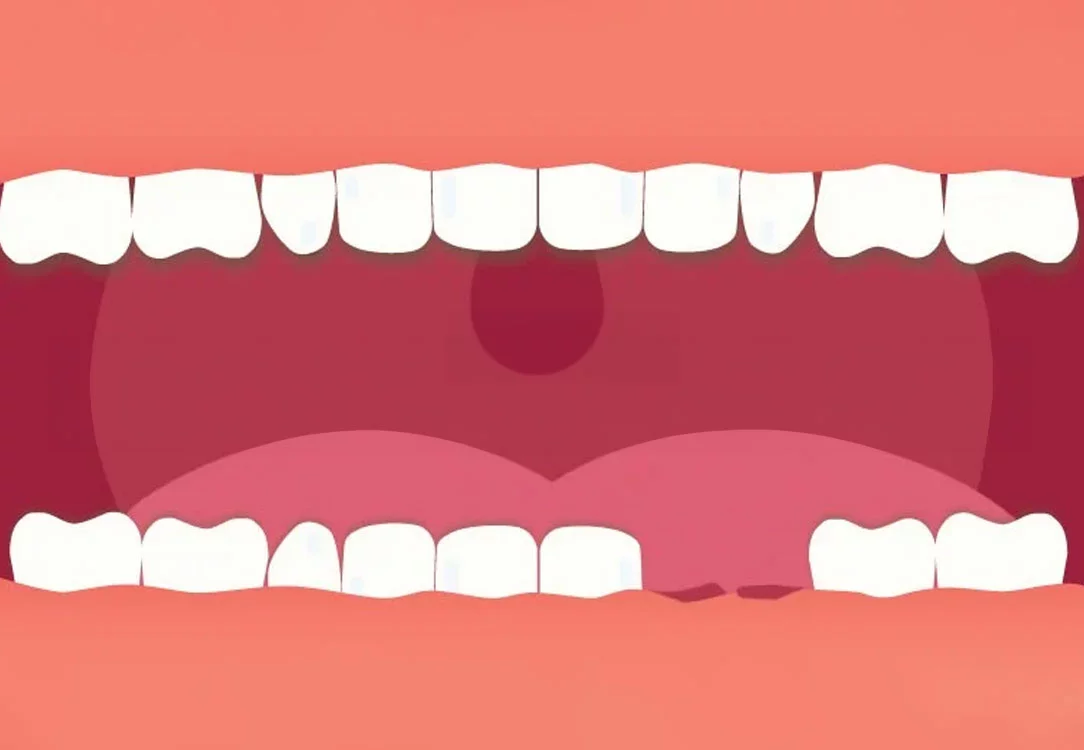Dental Bridge vs. Dental Implant
Dental bridges are used to fill or “bridge” the gaps left by one or more missing teeth. The most common type is a traditional fixed bridge. It may be used when you have one or more healthy teeth on either side of a missing tooth or gap. A traditional fixed bridge involves one or more replacement teeth, known as pontics, with crowns on either side. The crowns are cemented on top of the healthy teeth to secure the bridge. A similar option, the cantilever bridge, is held in place by just one crowned healthy tooth.
Dental implants are a surgical option for replacing missing teeth. They’re made of a metal post that’s surgically implanted in the jawbone and a replacement tooth that’s securely attached to the post. An implant replaces both the missing tooth and its root, so it looks and functions like a natural tooth, explains the American Academy of Periodontology.
Implant-Supported Bridges
Choosing Between a Dental Bridge vs. Dental Implant
- To place a traditional fixed bridge, your dentist will need to reshape the healthy teeth that will receive the crowns. No reshaping is necessary with dental implants.
- Dental implants are surgically implanted in your jawbone. Traditional fixed bridges are a non-surgical option as they are cemented to your teeth.
- Dental implants may last for decades, according to the American Academy of Implant Dentistry. Dental bridges generally last five to seven years.
Tooth Bridge vs. Dentures
Dentures are another possible option for replacing missing teeth. There are two main types of dentures: complete and partial. Let’s take a look at these denture options.

Choosing Between a Dental Bridge vs. Partial Denture
- Traditional fixed bridges are cemented in place by your dentist, while you can put in and take out partial dentures on your own.
- Partial dentures don’t require any changes to adjacent teeth, but with traditional fixed bridges, your dentist will need to reshape these teeth to make room for crowns.
- A dental bridge that’s secured by crowns has a natural appearance, while the metal framework that holds a partial denture in place may be more noticeable.
Dental Bridge vs. Tooth Crown
A dental crown is a tooth-shaped cap that’s cemented on top of a damaged or decayed tooth. Crowns cover the entire visible portion of the tooth and could be made of various materials, from shiny gold to tooth-colored resin or porcelain. Dentists may place crowns for a long list of reasons, including:
- Restoring a severely decayed tooth.
- Saving a cracked or broken tooth.
- Protecting a tooth after root canal treatment.
- Concealing a severely discolored tooth.
- Restoring a tooth that’s been worn down by clenching or grinding.
Choosing Between a Dental Bridge vs. Crown

Dental Bridge After Care & Recovery
- Traditional fixed bridge. Since the procedure involves reshaping the teeth that will receive crowns, you may experience some discomfort once the anesthesia wears off. The crowned teeth may be sensitive, especially to hot or cold foods and drinks. A tooth that’s received a crown should feel normal within just a few days.
- Implant-supported bridge. After getting dental implant posts placed, you may feel pain at the implant site. Other post-surgery discomforts could include bruising or swelling of your gums and skin, as well as some minor bleeding. Your surgical site may take around two weeks to heal.
- Removable bridges. When you first get partial dentures, they may feel bulky or uncomfortable in your mouth. This should go away as you get used to wearing your new bridge. If you feel gum pain or discomfort, let your dentist know. This could mean your new removable bridges need to be adjusted.
How To Take Care of Dental Bridges
Find a Dentist for Dental Bridges Near You
Dental bridges, as well as dentures, crowns, and dental implants, can restore the look and function of your smile. To learn more about your options for replacing missing teeth, talk to your dentist. If you don’t have a dentist and you're asking yourself where to find a trusted dentist near me, our Find a Dentist tool can connect you with Smile-Generation trusted dental offices in your community.
Find your trusted, local dentist today!
Sources
- https://www.prosthodontics.org/assets/1/7/ACP_Talking_points_for_Missing_Teeth_1-12-15.pdf
- https://my.clevelandclinic.org/health/treatments/10921-dental-bridges
- https://www.perio.org/for-patients/periodontal-treatments-and-procedures/dental-implant-procedures/single-tooth-dental-implants/
- https://www.aaid-implant.org/faqs/
- https://www.mouthhealthy.org/en/az-topics/d/dentures-partial
- https://www.colgate.com/en-us/oral-health/bridges-and-crowns/your-dental-crown-procedure-what-to-expect
- https://www.mayoclinic.org/tests-procedures/dental-implant-surgery/about/pac-20384622
- https://www.mouthhealthy.org/en/nutrition/nutrition-concerns
Smile Generation blog articles are reviewed by a licensed dental professional before publishing. However, we present this information for educational purposes only with the intent to promote readers’ understanding of oral health and oral healthcare treatment options and technology. We do not intend for our blog content to substitute for professional dental care and clinical advice, diagnosis, or treatment planning provided by a licensed dental professional. Smile Generation always recommends seeking the advice of a dentist, physician, or other licensed healthcare professional for a dental or medical condition or treatment.








